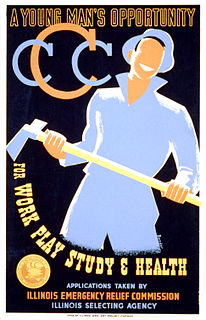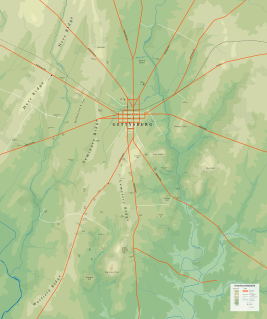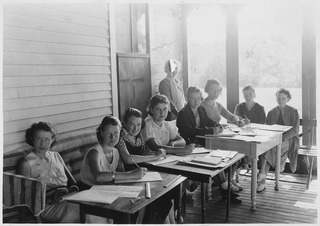The McMillan Woods CCC camp was Civilian Conservation Corps camp NP-2 [1] on the Gettysburg Battlefield planned in September 1933 near CCC Camp Renaissance in Pitzer Woods (camp NP-1). Captain Francis J. Moran moved from Camp Renaissance to become the new camp NP-2 commander in October 1933 [2] (supervisors under Superintendent Farrell included Charles Heilman in 1936, and Major Renn Lawrence was the 1937 CCC sub-district commander.) The camp opened a new recreation hall in 1934 and provided manpower for building the veterans camp for the 1938 Gettysburg reunion, [3] and about 50 enrollees of CCC Company #1355-C served as aides for unaccompanied veterans. During the reunion, Company F of the 34th Infantry used the CCC camp and had a headquarters office under Major C. Gilchrist (executive officer of the "regular army camp") [4] and Capt. E. E. Wright. Captain Frederick L. Slade was the CCC commander on April 1, 1939.
McMillan Woods is a Gettysburg Battlefield forested area used during the Battle of Gettysburg and for camps after the American Civil War, including a CCC camp and the subsequent WWII POW camp at Gettysburg. The woods includes Rifle Pits and Earth Works from the battle

The Civilian Conservation Corps (CCC) was a voluntary public work relief program that operated from 1933 to 1942 in the United States for unemployed, unmarried men. Originally for young men ages 18–25, it was eventually expanded to ages 17–28. Robert Fechner was the first director of this agency, succeeded by James McEntee following Fechner's death. The CCC was a major part of President Franklin D. Roosevelt's New Deal that provided unskilled manual labor jobs related to the conservation and development of natural resources in rural lands owned by federal, state, and local governments. The CCC was designed to provide jobs for young men and to relieve families who had difficulty finding jobs during the Great Depression in the United States. Maximum enrollment at any one time was 300,000. Through the course of its nine years in operation, 3 million young men participated in the CCC, which provided them with shelter, clothing, and food, together with a wage of $30 per month.

The Gettysburg Battlefield is the area of the July 1–3, 1863, military engagements of the Battle of Gettysburg within and around the borough of Gettysburg, Pennsylvania. Locations of military engagements extend from the 4-acre (1.6 ha) site of the first shot at Knoxlyn Ridge on the west of the borough, to East Cavalry Field on the east. A military engagement prior to the battle was conducted at the Gettysburg Railroad trestle over Rock Creek, which was burned on June 27.
In 1939, the McMillan Woods CCC camp became the 1st under an "all colored staff" when the white supervisory personnel transferred to the Blue Knob CCC camp (the camp's singing quartet made public appearances in 1939.) The camp worked on Jones Battalion avenue and constructed a new walkway on Big Round Top. [5] The commander in 1940 was Captain Webb, and in March 1942, the McMillan Woods CCC camp was to be abandoned (the facility became the 1944-5 World War II POW camp at Gettysburg.)

Blue Knob State Park is a 6,128-acre (2,480 ha) Pennsylvania state park in Kimmel, Lincoln, and Pavia townships in Bedford County, Pennsylvania, in the United States. The average annual snowfall at the park is about 12 feet (370 cm). The park is named for Blue Knob, the second highest mountain in Pennsylvania at 3,146 feet (959 m). It is the location of Blue Knob All Seasons Resort, the ski slope in Pennsylvania with the highest elevation. Blue Knob State Park is just off Interstate 99 on Pennsylvania Route 869 west of Pavia.

Big Round Top is a boulder-strewn hill notable as the topographic high point of the Gettysburg Battlefield and for 1863 American Civil War engagements for which Medals of Honor were awarded. In addition to battle monuments, a historic postbellum structure on the uninhabited hill is the Big Round Top Observation Tower Foundation Ruin.
The World War II Prisoner of War camp on the Gettysburg Battlefield operated from June 29, 1945, through April 1946 at the former site of the McMillan Woods CCC camp.









